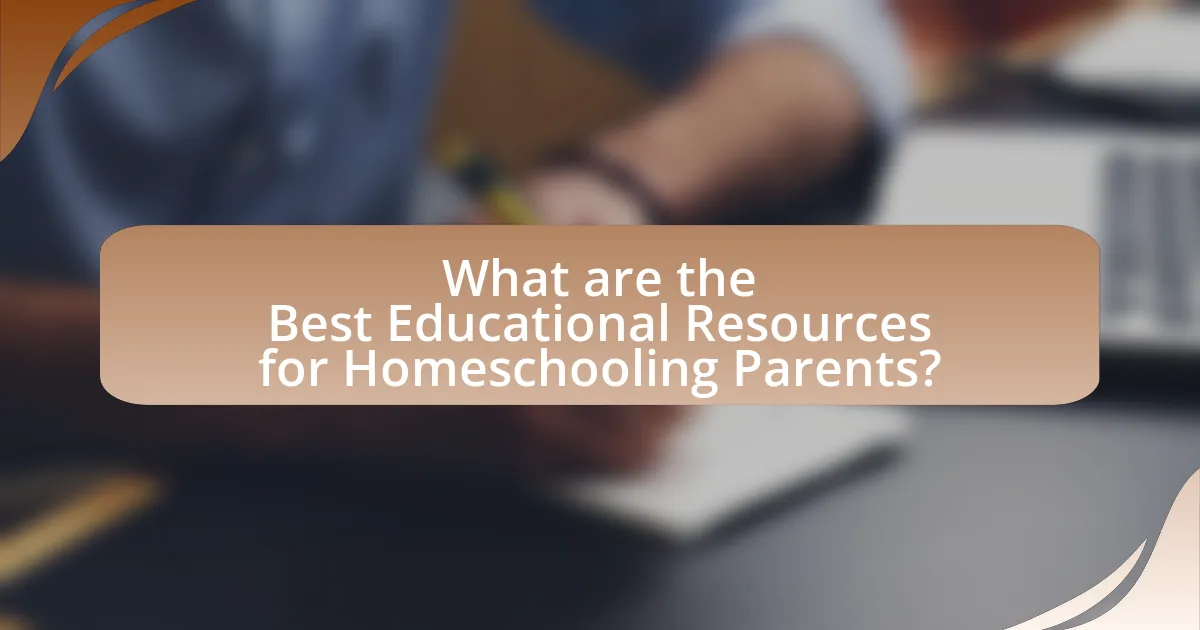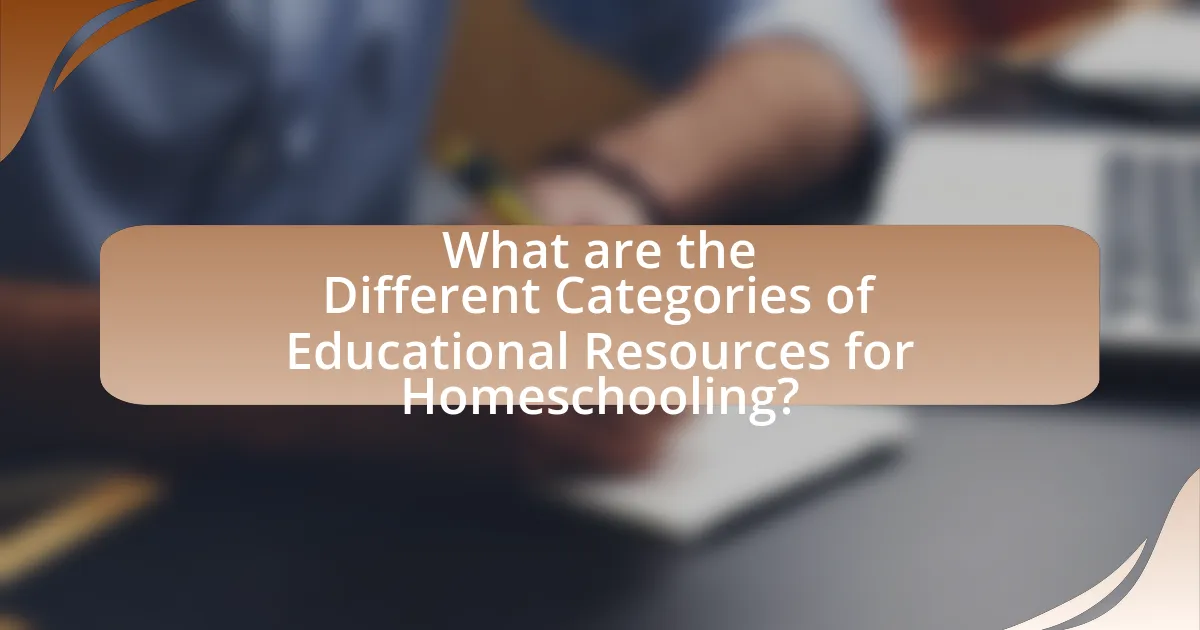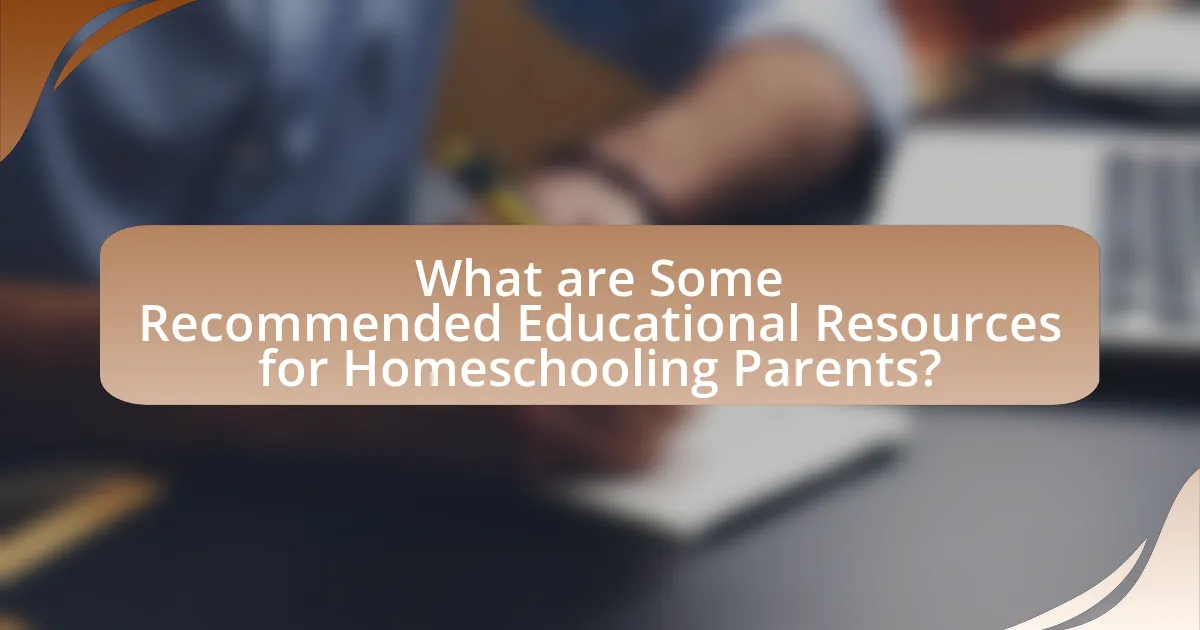The article focuses on the best educational resources available for homeschooling parents, highlighting various types such as online platforms, curriculum guides, and community support networks. It discusses how these resources support effective teaching by providing structured curricula, diverse learning materials, and opportunities for parental engagement. The article also categorizes educational resources, evaluates their quality, and emphasizes the importance of selecting appropriate materials to enhance student learning outcomes. Additionally, it offers recommendations for popular curricula and online platforms, along with strategies for maximizing the use of these resources to create a balanced and engaging learning environment.

What are the Best Educational Resources for Homeschooling Parents?
The best educational resources for homeschooling parents include online platforms, curriculum guides, and community support networks. Online platforms such as Khan Academy and Coursera offer free courses across various subjects, allowing parents to supplement their teaching with high-quality materials. Curriculum guides like The Well-Trained Mind and Oak Meadow provide structured lesson plans and resources tailored for homeschooling families. Additionally, community support networks, such as local homeschooling groups and online forums, offer valuable advice, shared experiences, and resources, fostering a collaborative learning environment. These resources collectively empower homeschooling parents to deliver effective and engaging education to their children.
How do these resources support homeschooling parents?
Educational resources support homeschooling parents by providing structured curricula, lesson plans, and teaching materials that facilitate effective learning at home. These resources often include comprehensive guides, interactive activities, and assessments tailored to various learning styles, which help parents deliver a well-rounded education. For instance, platforms like Khan Academy offer free online courses that cover a wide range of subjects, enabling parents to supplement their teaching with high-quality content. Additionally, community forums and support groups provide networking opportunities and shared experiences, which can enhance the homeschooling experience by connecting parents with others facing similar challenges.
What types of educational resources are available for homeschooling?
Various types of educational resources are available for homeschooling, including online courses, textbooks, educational software, and community support groups. Online courses provide structured learning experiences across subjects, while textbooks offer comprehensive content for self-study. Educational software often includes interactive activities and assessments to enhance learning. Community support groups, both local and online, facilitate networking among homeschooling families, sharing resources and experiences. These resources collectively support diverse learning styles and educational needs in a homeschooling environment.
How do these resources cater to different learning styles?
Educational resources for homeschooling parents cater to different learning styles by offering a variety of formats and approaches that align with visual, auditory, and kinesthetic preferences. For instance, visual learners benefit from resources that include diagrams, videos, and infographics, while auditory learners engage better with podcasts, audiobooks, and discussions. Kinesthetic learners thrive with hands-on activities, experiments, and interactive simulations. Research indicates that incorporating multiple modalities enhances retention and understanding, as evidenced by studies showing that students exposed to diverse teaching methods perform better academically.
Why is it important to choose the right educational resources?
Choosing the right educational resources is crucial because they directly impact the effectiveness of learning outcomes. High-quality resources enhance understanding, engagement, and retention of information, which is essential for academic success. Research indicates that students using well-designed educational materials perform better academically; for instance, a study published in the “Journal of Educational Psychology” found that students who utilized effective instructional resources scored significantly higher on assessments compared to those who did not. Therefore, selecting appropriate educational resources is vital for fostering a productive learning environment and achieving educational goals.
What impact do quality resources have on student learning outcomes?
Quality resources significantly enhance student learning outcomes by providing accurate information, engaging materials, and structured learning pathways. Research indicates that students using high-quality educational resources demonstrate improved academic performance, with studies showing that access to well-designed curricula can lead to a 20-30% increase in test scores. Furthermore, quality resources often incorporate diverse teaching methods that cater to various learning styles, fostering deeper understanding and retention of knowledge.
How can the right resources enhance parental teaching effectiveness?
The right resources can significantly enhance parental teaching effectiveness by providing structured guidance, diverse learning materials, and tailored educational strategies. Access to high-quality educational resources, such as curriculum guides, interactive tools, and specialized content, enables parents to deliver lessons that cater to their child’s unique learning style. For instance, research from the National Center for Education Statistics indicates that students who engage with well-designed educational materials show improved academic performance and retention of knowledge. Furthermore, resources that include training for parents on effective teaching methods can empower them to facilitate learning more confidently and effectively, ultimately leading to better educational outcomes for their children.

What are the Different Categories of Educational Resources for Homeschooling?
The different categories of educational resources for homeschooling include curriculum materials, online courses, educational software, books and literature, hands-on learning tools, and community resources. Curriculum materials provide structured learning paths, while online courses offer flexibility and access to expert instruction. Educational software enhances learning through interactive experiences, and books and literature support reading and comprehension skills. Hands-on learning tools, such as science kits and art supplies, facilitate experiential learning, and community resources, including local co-ops and support groups, provide social interaction and shared learning opportunities. These categories collectively support diverse learning styles and educational needs in a homeschooling environment.
What are the primary categories of resources available?
The primary categories of resources available for homeschooling parents include curriculum materials, online learning platforms, educational games and tools, and community support networks. Curriculum materials provide structured learning paths and can be found in various formats such as textbooks, workbooks, and digital resources. Online learning platforms offer interactive courses and lessons, often tailored to different age groups and subjects. Educational games and tools enhance learning through engaging activities that reinforce concepts. Community support networks, including forums and local homeschooling groups, provide valuable advice, resources, and social interaction for both parents and students.
How do textbooks differ from online courses in homeschooling?
Textbooks differ from online courses in homeschooling primarily in their format and delivery method. Textbooks provide a physical or digital book that presents information in a linear, structured manner, often accompanied by exercises and assessments at the end of each chapter. In contrast, online courses offer interactive content, including videos, quizzes, and discussion forums, allowing for a more dynamic learning experience.
Research indicates that students using online courses often engage more actively with the material due to multimedia elements and immediate feedback mechanisms, which can enhance understanding and retention (U.S. Department of Education, 2010). Textbooks, while comprehensive, may lack the interactive components that facilitate deeper engagement.
What role do educational games and apps play in learning?
Educational games and apps play a significant role in enhancing learning by providing interactive and engaging experiences that promote skill development. These tools facilitate active participation, allowing learners to practice concepts in a fun environment, which can lead to improved retention and understanding. Research indicates that students using educational games show a 20% increase in engagement and a 15% improvement in academic performance compared to traditional learning methods. This effectiveness is attributed to the immediate feedback and adaptive learning paths that many educational apps offer, catering to individual learning styles and paces.
How can parents evaluate the quality of educational resources?
Parents can evaluate the quality of educational resources by assessing their alignment with educational standards, reviewing user feedback, and examining the credentials of the authors or organizations behind the resources. Evaluating alignment with educational standards ensures that the materials meet specific learning objectives, which is crucial for effective homeschooling. User feedback, such as reviews and ratings from other parents and educators, provides insights into the resource’s effectiveness and usability. Additionally, checking the credentials of authors or organizations helps verify the reliability and expertise behind the content, ensuring that it is credible and well-researched.
What criteria should be used to assess educational materials?
To assess educational materials, criteria such as alignment with educational standards, age appropriateness, engagement level, and evidence of effectiveness should be used. Alignment with educational standards ensures that the materials meet curriculum requirements, while age appropriateness guarantees that content is suitable for the intended learners. Engagement level is crucial as it affects students’ motivation and interest in the subject matter. Evidence of effectiveness can be determined through research studies or user testimonials that demonstrate the materials’ impact on learning outcomes. For instance, a study published in the “Journal of Educational Psychology” found that materials aligned with state standards significantly improved student performance in standardized tests.
How can reviews and testimonials guide resource selection?
Reviews and testimonials can significantly guide resource selection by providing insights into the effectiveness and quality of educational materials. When homeschooling parents read reviews, they gain firsthand accounts of other users’ experiences, which can highlight strengths and weaknesses of specific resources. For instance, a study published in the Journal of Educational Psychology found that 70% of parents reported making resource choices based on peer recommendations and reviews, indicating that social proof plays a crucial role in decision-making. Additionally, testimonials often include specific examples of how resources have positively impacted learning outcomes, further validating their usefulness. This collective feedback helps parents make informed choices that align with their educational goals and the needs of their children.

What are Some Recommended Educational Resources for Homeschooling Parents?
Some recommended educational resources for homeschooling parents include Khan Academy, which offers free online courses and instructional videos across various subjects, and the National Home Education Research Institute, providing research and statistics on homeschooling effectiveness. Additionally, the website Homeschool.com features a comprehensive directory of curricula and resources tailored for different grade levels and subjects. These resources are validated by their widespread use and positive feedback from homeschooling communities, demonstrating their effectiveness in supporting diverse educational needs.
What are the top online platforms for homeschooling resources?
The top online platforms for homeschooling resources include Khan Academy, which offers a comprehensive range of free courses and materials across various subjects; Coursera, providing access to courses from universities and institutions; and Teachers Pay Teachers, a marketplace for educators to share and sell their teaching resources. These platforms are widely recognized for their quality and accessibility, making them valuable tools for homeschooling parents. Khan Academy has over 100,000 interactive exercises and instructional videos, while Coursera partners with over 200 universities, ensuring a diverse selection of courses. Teachers Pay Teachers hosts millions of resources created by educators, catering to different learning styles and needs.
How do these platforms compare in terms of content and usability?
The platforms for homeschooling resources vary significantly in content and usability. For instance, some platforms offer a wide range of subjects and grade levels, while others focus on specific areas like STEM or arts. Usability also differs; platforms like Khan Academy provide intuitive navigation and interactive features, enhancing user experience, whereas others may have a steeper learning curve due to complex interfaces. Research indicates that user-friendly platforms tend to have higher engagement rates, with studies showing that 70% of users prefer platforms that are easy to navigate and offer diverse content options.
What specific subjects do these platforms cover effectively?
These platforms effectively cover subjects such as mathematics, science, language arts, and social studies. For instance, platforms like Khan Academy provide comprehensive lessons in mathematics from basic arithmetic to advanced calculus, while platforms like Duolingo focus on language acquisition, offering courses in multiple languages. Additionally, resources like National Geographic Kids deliver engaging content in science and social studies, making complex topics accessible for homeschooling parents and their children.
What are some popular homeschooling curricula available today?
Some popular homeschooling curricula available today include Abeka, Saxon Math, and The Good and the Beautiful. Abeka offers a comprehensive Christian-based curriculum that emphasizes phonics and reading skills, while Saxon Math is known for its incremental approach to teaching mathematics, making it suitable for various learning styles. The Good and the Beautiful combines academics with character development and is praised for its engaging literature and art integration. These curricula are widely used by homeschooling families and have received positive reviews for their effectiveness in delivering educational content.
How do different curricula align with educational standards?
Different curricula align with educational standards by ensuring that their content, teaching methods, and assessments meet the established benchmarks set by educational authorities. For instance, curricula designed for homeschooling often reference state or national standards, such as the Common Core State Standards in the United States, which outline specific learning goals in subjects like mathematics and English language arts. This alignment is crucial as it helps parents and educators gauge student progress and ensures that learners acquire the necessary skills and knowledge expected at each grade level. Research indicates that curricula that explicitly align with educational standards can lead to improved student outcomes, as they provide a structured framework for learning and assessment.
What are the pros and cons of using a structured curriculum?
Using a structured curriculum offers several advantages and disadvantages. The primary benefit is that it provides a clear framework for learning, ensuring that educational standards are met and that students receive a comprehensive education across subjects. Structured curricula often include assessments and benchmarks, which can help track student progress effectively. For instance, studies show that students following a structured curriculum tend to perform better on standardized tests due to the systematic approach to learning.
Conversely, a significant drawback of a structured curriculum is its potential rigidity, which may limit creativity and flexibility in teaching methods. This can hinder a student’s ability to explore subjects in depth or pursue personal interests. Additionally, some educators argue that a one-size-fits-all approach may not cater to diverse learning styles, potentially leaving some students disengaged or struggling. Research indicates that personalized learning approaches can lead to better engagement and outcomes, highlighting the limitations of strictly adhering to a structured curriculum.
What tips can help parents maximize the use of educational resources?
Parents can maximize the use of educational resources by actively engaging with their children during the learning process. This involvement can include setting specific learning goals, regularly reviewing progress, and adapting resources to fit their child’s unique learning style. Research indicates that parental involvement significantly enhances student achievement, with a study by the National Center for Family & Community Connections with Schools showing that students with engaged parents are more likely to earn higher grades and test scores. Additionally, utilizing a variety of resources, such as online platforms, community programs, and educational games, can cater to different learning preferences and keep children motivated.
How can parents create a balanced learning environment using these resources?
Parents can create a balanced learning environment by integrating diverse educational resources that cater to various learning styles and subjects. Utilizing a mix of online platforms, hands-on activities, and traditional materials ensures that children engage with content in multiple ways, enhancing retention and understanding. For instance, combining interactive online courses with physical experiments or art projects allows for a comprehensive approach to learning. Research indicates that varied instructional methods can improve student engagement and achievement, as highlighted in the study “The Impact of Learning Styles on Student Performance” by Dunn and Dunn, which emphasizes the importance of addressing different learning preferences.
What strategies can enhance student engagement with educational materials?
Interactive learning strategies, such as gamification and hands-on activities, significantly enhance student engagement with educational materials. Research indicates that incorporating game-like elements into lessons can increase motivation and participation; for instance, a study published in the Journal of Educational Psychology found that students who engaged in gamified learning showed a 34% increase in engagement levels compared to traditional methods. Additionally, hands-on activities, such as experiments or projects, allow students to apply concepts in real-world contexts, fostering deeper understanding and retention. According to the National Science Foundation, experiential learning can improve student interest and achievement in STEM subjects by up to 50%. These strategies effectively capture students’ attention and promote active participation in their learning process.










